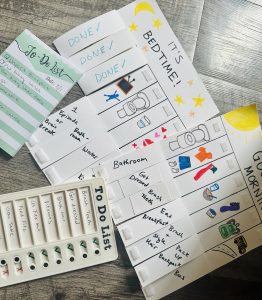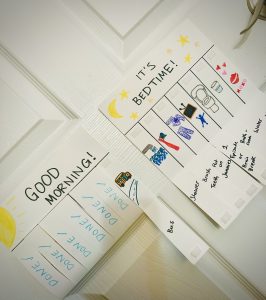Raise your hand if you’ve ever been personally victimized by starting the year with routines in place that quickly get forgotten by the second or third week of the school year …
It’s me. Hi 👋
Here’s the thing y’all.
You’ll find plenty of resources on Etsy, Instagram, etc., promising to be the PERFECT routine that will solve EVERYTHING.
Want to know what the perfect routine actually is?
I’d give it to you, but I can’t.
Because the perfect routine is one that you and your family come up with together.
It’s a routine that is as unique as your beautiful family is!
A routine that your child is a part of creating is much more likely to be successful than anything you could find online. Best of all, involving your child in creating a routine exercises those key executive functioning skills of planning, prioritizing, and time management.
Let me quickly share with you the traps we typically fall into and what we CAN do to make sure routines stick for our families!
- Too complicated. Routines with a lot of steps can feel overwhelming and hard to remember. When it comes to routines, less is often more.
- Inconsistency! If this isn’t used frequently, it will be quickly forgotten.
- Not important. Does your child see the value in this routine, or does it feel like just one more thing adults are nagging them to do?
- Too hard. Does your child feel confident in completing each step of the routine independently? It’s hard to try when you already feel like you’re going to fail.
So, there are a lot of ways routines can go awry. But how do we make them “stick” with school creeping around the corner?
- Child-led: Involving your child in creating a routine can increase buy-in and create a sense of ownership
- Simple: Focus on the most important steps and keeping the steps simple! (For example, brushing teeth can include putting toothbrush on your toothpaste, turning on the water, washing the toothbrush off, etc. This can all be practiced together!)
- Logical: Make sure the order of the routine is logical and natural. Try to minimize moving back and forth throughout the house, as it can cause distraction (For example, get dressed before leaving the bedroom for breakfast)
- Consistent: Use the routine daily. It’s okay to prompt and remind your child in the beginning, but don’t do it for them! Help guide them along.
- Motivating: How does the routine help your child? Does completing it in time allow for extra time to do a preferred activity? This is SO often the missing piece!
Not sure where to start?
Start by talking with your child and making a list together! A visual representation of a routine is SO important, as it takes pressure off of your child’s working memory and helps them plan and prioritize their actions. Most importantly, it allows them to SEE their progress through each of the steps! (And mamas, you know there’s no greater feeling than checking something off! ✅)
Younger children can benefit from routines depicted through images – you can even take photos of them doing each step to use in the visual routine! Checklists work great for older children.


Together, practice going through the routine, and modify as needed so it is well established when that first day of school rolls around!
You’ve got this!










